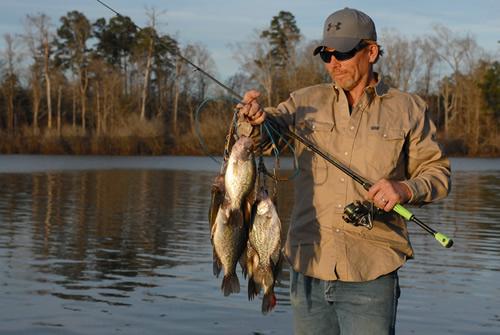
Shane Hale with a few keeper crappie boated during a recent "meat run" to the Angelina River. (Photo by Matt Williams)
February 9, 2018 - There is a party brewing on river systems all across eastern Texas. Depending on who you talk to along the Angelina, Sabine, Neches or Trinity, the fun may have already begun.
Shane Hale and his buddies have been enjoying good times on the Angelina River for several weeks now. Interestingly, they will probably be changing hats and playing an entirely different game within a couple of weeks. Possibly sooner.
For more than a month now, Hale has been snatching steady limits of black crappie from the upper reaches of the tea-colored river, well beyond the State Highway 103 bridge.
"It's been pretty good," said Hale, sandblasting/paint contractor from Appleby. "A few weeks ago, when the water temperatures dropped down into the 40s, the fish got really lethargic. You could hardly feel them bite. You'd just raise your rod and one would be there. It's warmed up a little and they've gotten a little more aggressive, but not much."
What the crappie are lacking in energy they are making up for in numbers. Hale showed me one of his sweet spots on a recent afternoon and his sonar screen turned black with fish that looked to be holding about a foot off bottom. We caught crappie for the better part of three hours and only a handful of them needed to go to the measuring board. Equal numbers can on jigs and shiners, but jigs deadsticked near bottom seemed to produce the bigger fish.
"They've been stacked in here," Hale said. "They aren't everywhere by any means but once you find them there are a bunch of them."
Hale has located fish in multiple locations up and down the Angelina and says the most productive ones can vary from one year to the next. His best spot this winter has been a defined river bend at the mouth of an old slough. The water in the bend is about 18 feet deep.
"It's the deepest hole around the whole area," Hale said. "It's not that hard to find the sweet spots when the crappie are in the river, though. Just look for all the boats. I've seen as many as 10-15 boats sitting side-by-side with everybody catching fish."
Hale believes the crappie are attracted to the river's upper reaches by a bounty of bait fish, primarily threadfin shad.
"They show up in the river just about every year, provided the conditions are right," he said. "If we get a bunch of rain that creates a lot of current it really messes it up. It seems like we'll have a good crappie run about two out of every five years. This year has been a good one. My freezer is full."
Good as the crappie fishing has been, Hale isn't looking for it to last much longer. The white bass will see to that.

Go gunning for white bass on an East Texas river system during the spring spawning run and you can't go wrong with a 1/4 ounce Blakmore Roadrunnner. (Photo by Matt Williams)
"Once the white bass show up in the river the crappie and everything else will leave," Hale said. "I've seen it happen more than once. It's not going to be long."
Chasing Whites: The Big Show
Thousands of anglers around Texas turn their attention to white bass this time of year. And it almost always revolves around one of the most reliable and enjoyable games in town - the spring spawning run.
I call the spawning run enjoyable because that's exactly what it is. In fact, if you like catching thick-shouldered fish, often in rapid succession, there may not be a more entertaining way to spend an afternoon during early spring than fishing for white bass.
It's not uncommon for hundreds - possibly thousands - of hungry, aggressive fish to stack in small areas when curtain time falls on the spring spawning run. Toss a small spinner like a Blakemore Roadrunner, shallow running crankbait or Beetle Spin into a small army of whites and chances are better than good the bait is going to get whacked.
When conditions are right, swarms of white bass will point their noses into the current and begin finning their way upstream in rivers and creeks that feed major reservoirs like Sam Rayburn, Toledo Bend, Richland Chambers, Livingston, Cooper, Cedar Creek, Somerville and Tawakoni, just to name a few.
The males are the first ones to make the journey, then the females. There is not much organization once the actual spawning process gets underway. Nor is there a boyfriend/girlfriend relationship established among the fish.
A female white bass may be in the company of several males when she releases her eggs. The males react by spewing milt that fertilizes the eggs, which in turn drift slowly downstream until they attach to a log, rock or some other underwater obstruction.
The eggs generally hatch within a few days and the juveniles continue the journey back to the lake proper. Those that survive the trip will grow to become the next generation of white bass for anglers to catch.
What Triggers It?
I've heard all sorts of theories as to what spurs white bass to race upstream and do their thing. According to most fisheries scientists, the annual spawning run is triggered by a number of factors.
The primary ones are photoperiod (the length of days and nights), how much water is rolling down the river and water temperature. Those factors - especially river flow - also play a role in how successful the spawning efforts will be and how many youngsters are ultimately recruited into the population.
"From my observation, the primary factors that influence the spawning run are river flow and water temps," said Greg Binion, a TPWD fisheries biologist based in Corpus Christi. "Typically, river flow is an important component in these spawning runs. Years of slack flow tend to yield less successful angling in terms of catch and harvest. Water temps are another important variable to track during the runs. Specifically, as water temps begin to hit mid-to-high 50’s and into 60 degrees, the quality of angling tends to increase. A range of 58-60 degrees is a good number for anglers to key on."
Fisheries biologist Rick Ott of Tyler added that the annual spawning runs are always the most successful during years when river flows are normal to slightly above. Rain, or a lack thereof, is what dictates the intensity of river flows.
"River flow must be high enough to keep the fertilized eggs suspended and tumbling as they harden and the larvae develop," Ott said. "Even if both males and females are present, the river flow is the final trigger needed for spawning. Both spawning activity and hatching success of the fertilized eggs will be reduced if the timing of rain and river flow is out of phase with temperature and photoperiod. In years where multiple rainfall events occur and river flow are prolonged the actual spawning period is also prolonged. The runs are greatly reduced if rainfall occurs too early, too late or not at all."
Let the Games Begin
Naturally, the timing and intensity of the spring spawning run can vary with the river system up for discussion.
To wit:
One of the most prolific runs in Central Texas occurs on the Colorado River above Lake Buchanan. According to fisheries biologist Marcus De Jesús of San Marcos, it is usually March before the meat of spawning run gets underway on the Hill Country river.
Here in eastern Texas, things tend to get started a little earlier on the Angelina, Sabine, Neches and Trinity. There have already be reports of few males being caught on the Angelina, but not many females.
Sabine River fishing guide Jane Gallenbach said she began catching fish in the vicinity of River Ridge Campground on Jan. 31. She landed her first limit on Feb. 1, all on Blakemore Roadrunners fished slowly around sandbars and still-water eddies..
"It is just getting started," Gallenbach said. "The river is low but the water is really about as clear as it gets. We do have some current, but we could use some rain. There's not a lot of fish up yet, but they are coming. It should get better every day."
Lake Palestine fishing guide Rick Vandergriff says he thinks the spawning run is on the verge of busting wide open on the Neches River.
"There are few fish beginning the show up, but it's not going real good yet," Vandergriff said. "The cold weather has knocked the water temperature back a little. I'm betting it'll be going strong in another couple of weeks."
The folks at Lock 'N Dam Marina on the Trinity River above Lake Livingston filed a similar report on Feb. 1. The report said the river is in great shape and that anglers have begun picking up a few limits, mainly during the early morning hours using white and chartreuse jigs.
Curtain time for one of nature's greatest shows is just around the corner.
Matt Williams is a freelance writer based in Nacogdoches. He can be reached by e-mail, mattwillwrite4u@yahoo.com.









